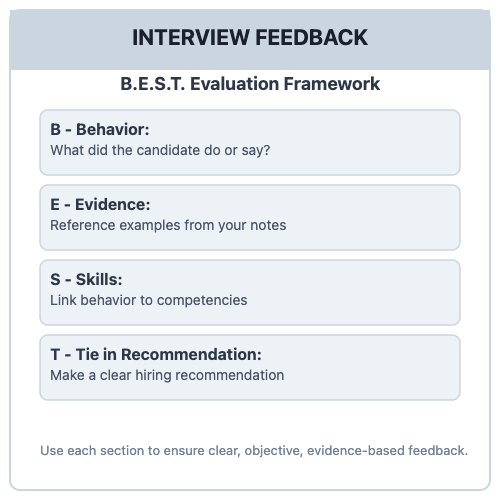Welcome to Writing Effective Evaluations.
As an interviewer, you play a key role in building strong engineering teams. The way you capture observations, organize your notes, and write evaluations directly shapes your team’s hiring decisions. When you focus on evidence and structure your feedback, you help ensure every candidate is assessed fairly and consistently. By mastering these skills, you’ll make your recommendations clearer, more actionable, and more trusted by your team.
In this course, you’ll learn how to:
- Organize and synthesize interview notes for clarity and fairness
- Use role-specific rubrics to assign scores based on behavioral evidence
- Avoid common pitfalls to maintain fairness and consistency
- Confidently justify your hiring recommendations
By the end of this lesson, you’ll be able to turn your interview notes into clear, objective evaluations that support fair and confident hiring decisions.
Strong evaluations start with strong notes. Instead of relying on gut feelings or general impressions, focus on what the candidate actually did or said. For example, rather than writing, "Seemed organized and easy to work with," capture observable actions like, "Outlined their approach to managing multiple project deadlines by creating a shared task board and regularly updating stakeholders."
Tips for effective note-taking:
- Group notes by competency or interview question
- Use direct quotes or clear paraphrasing
- Focus on specific, observable behaviors
For instance, "Described breaking down a tight deadline into daily tasks and updating the team regularly" is much more actionable than "Good communicator." This approach ensures you always have real evidence to support your evaluation.
When it’s time to write your evaluation, use the B.E.S.T. framework to keep your feedback clear, objective, and actionable:
- Behavior: Describe what the candidate actually did or said
- Evidence: Reference specific examples from your notes
- Skills/Competencies: Connect the behavior and evidence to the relevant competency
- Tie to Recommendation: Clearly state your hiring recommendation and justify it with the evidence

Avoid statements like, "Didn’t seem strong. Not sure they’re ready for the role." Instead, highlight specific behaviors and connect them to your decision. For example:
"The candidate struggled to break down a complex problem (Behavior), repeatedly jumping to solutions without clarifying requirements or outlining their approach (Evidence), which indicates gaps in problem-solving and communication skills (Skills/Competencies). Not recommending to advance because they did not demonstrate a structured approach or seek clarification, which are essential for this role (Tie to Recommendation)."
How to write strong evaluations:
- Reference concrete examples from your notes
- Connect evidence directly to the competencies you’re assessing
- Justify your recommendation (advance, hire, or reject) with clear evidence
The B.E.S.T. framework gives you a simple checklist to ensure your evaluations are structured, fair, and easy for your team to understand.
Here’s how you can shift from subjective impressions to objective, evidence-based notes in your evaluations. Let's see how this looks like in practice:
- Natalie: Hey Ryan, I just finished my interview notes, but I’m not sure if I’m being too subjective. For example, I wrote, "Seemed organized and easy to work with."
- Ryan: That’s a common habit, but it’s better to focus on what you actually observed. Did the candidate do something specific that showed they were organized?
- Natalie: Yes, during the project management question, they described how they created a shared task board and regularly updated stakeholders to keep everyone aligned.
